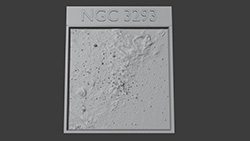CXC Home | Search | Help | Image Use Policy | Latest Images | Privacy | Accessibility | Glossary | Q&A
1
X-ray, Optical, & Infrared Images of NGC 3293Credit: X-ray: NASA/CXC/Penn State Univ./K. Getman et al.; Infrared: ESA/NASA JPL-Caltech/Herschel Space Observatory/JPL/IPAC; NASA JPL-Caltech/SSC/Spitzer Space Telescope; Optical: MPG/ESO/G. Beccari;
The NGC 3293 stellar cluster is one of 10 different systems that astronomers studied with Chandra to determine how magnetically active their stars are. Since most of the stars in these clusters are between 7 million and 25 million years old, the study gives a window into how stars like our Sun behaved at this age and how this could affect planets around them. These images of NGC 3293 show X-rays from Chandra, infrared data from Herschel and Spitzer, and optical data from the MPG/ESO 2.2-meter telescope in La Silla, Chile. The team found that the X-ray brightness of young, Sun-like stars is roughly constant for the first few million years, and then fades from 7 to 25 million years of age. This decrease happens more quickly for heftier stars.
2
3D Printable Files: NGC 3293 Tactile Plate (X-ray & Infrared) (3D Print Credit: NASA/CXC/A. Jubett, using software by Tactile Universe/N. Bonne & C. Krawczyk & Blender)
NGC 3293 is a star cluster about 8,300 light years from Earth. This tactile plate depicts NGC 3293 as a physical relief map based on the intensity of X-ray data captured by Chandra and infrared data from Spitzer and Herschel. The file for this plate can be downloaded and 3D-printed for learners to touch.
This image of NGC 3293 resembles a cone of bright stars and wispy clouds, set against a starry sky. The narrow point of the roughly cone-shaped cloud rests in the center of the image with the wide mouth at our upper right. The narrow end of the cone shape features dozens of large, bright, gleaming stars as sharp points. The background of the plate is packed with more stars that make up the cluster.
This image of NGC 3293 resembles a cone of bright stars and wispy clouds, set against a starry sky. The narrow point of the roughly cone-shaped cloud rests in the center of the image with the wide mouth at our upper right. The narrow end of the cone shape features dozens of large, bright, gleaming stars as sharp points. The background of the plate is packed with more stars that make up the cluster.
Return to: Chandra Sees Stellar X-rays Exceeding Safety Limits (December 15, 2022)








